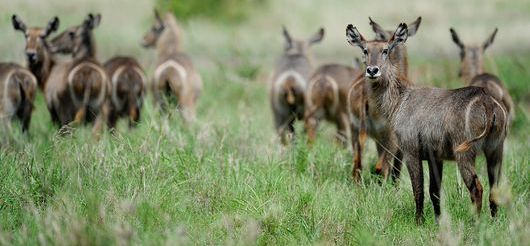Co-developing a community camera trapping programme to deliver benefits of living with wildlife
04 March 2022
04 March 2022
The Rungwa-Ruaha landscape in United Republic of Tanzania at nearly 50 000 km2 is one of the most important wildlife areas in Africa and it supports one of the world’s largest remaining populations of lions Panthera leo and globally significant populations of African wild dogs Lycaon pictus, cheetahs Acinonyx jubatus,...
The presence of forested islands creates edge habitats for many wildlife species, such as jaguar Panthera onca, tapir Tapirus terrestris, capybara Hydrochaeris hydrochaeris, harpy eagle Harpia harpyja, to name a few. The human population density in the region is very low (0.4 people/km2), with communities consisting of predominantly indigenous Makushi...
Sanjay Gandhi National Park (SGNP) is one of four parks in the world adjacent to a large metropolis, that occupies about 100 km2 with a minimum density of ~20 000 people/km2 and contains diverse wildlife such as chital Axis axis, sambhar Rusa unicolor, mugger crocodiles Crocodylus palustris, macaques Macaca mulatta...
Managing forest, supporting wildlife: Can biodiversity thrive in responsibly logged tropical forests? – Case Study of the Peruvian Amazon–WWF
16 December 2019
16 December 2019
Commercial logging in tropical forests can degrade ecosystems and fragment habitats, threatening biodiversity. However, when logging is responsibly managed, it has the potential to support local livelihoods and economic development while conserving biodiversity and the other vital services that forests provide. To understand more about the impacts of forest management...
Forest and wildlife resource-conservation efforts based on indigenous knowledge: The case of Nharira community in Chikomba district, Zimbabwe
16 December 2019
16 December 2019
Forest and wildlife resources are indispensable for the provision of ecosystem goods and services; as well as spiritual and cultural values in rural areas. In most unprotected areas, these resources are increasingly under threat prompting indigenous communities to apply their local knowledge in an effort to conserve them. This study...
Large areas of tropical forest have been designated for timber production. In this study, large-scale camera trap surveys were used to evaluate terrestrial mammal communities, with special emphasis on jaguars, in FSC certified logging concessions in Guatemala and Peru and assess the impact of reduced-impact logging in certified concessions upon...
Beehive fences as a multidimensional conflict-mitigation tool for farmers coexisting with elephants
16 December 2019
16 December 2019
Increasing habitat fragmentation and human population growth in Africa has resulted in an escalation in human-elephant conflict between small-scale farmers and free-ranging African elephants (Loxodonta Africana). This article tested the efficacy of a beehive fence design to keep elephants away from invading small-scale farms, as part of the 10-year Conservation...
Women, Human-Wildlife Conflict, and CBNRM: Hidden Impacts and Vulnerabilities in Kwandu Conservancy, Namibia
16 December 2019
16 December 2019
In Kwandu Conservancy, the effects of human-wildlife conflict are ongoing, reaching beyond direct material losses to include hidden impacts such as persistent worries about food insecurity, fears for physical safety, and lost investments. Existing vulnerabilities make some women more susceptible to wildlife impacts, and less able to recover from losses...
This study case examines Human Wildlife Conflict-HWC in an agricultural village located at the border of Rajaji National Park in Uttarakhand, India. It investigates: what are the “visible” and “hidden” costs of such conflict with wildlife? To what extent are these costs differentially borne by men and women? How do...
This article uses the context of deer management in Cuyahoga Valley National Park to examine the role genders plays in the relationship among wildlife values, beliefs about outcomes of lethal deer control, attitudes toward lethal deer control, and the perceived personal impacts of this management action. More specifically, it investigates...

